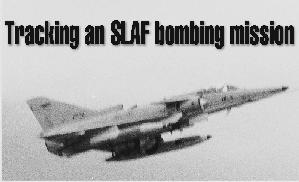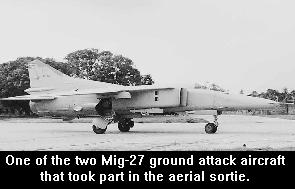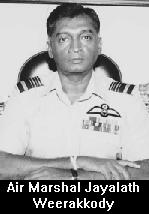
4th February 2001
Front Page|
News/Comment|
Plus| Business| Sports|
Mirror Magazine

![]()
Tracking an SLAF bombing mission
 The
voice from the cockpit in Cobra One came loud and clear. Somewhere in a
secure corner of the Air Force base in Katunayake, the Mission Commander
was doing a systems check with pilots in Cobra Two and Three. It was a
not so bright Thursday afternoon this week.
The
voice from the cockpit in Cobra One came loud and clear. Somewhere in a
secure corner of the Air Force base in Katunayake, the Mission Commander
was doing a systems check with pilots in Cobra Two and Three. It was a
not so bright Thursday afternoon this week.
Within seconds, the voice of one pilot after another followed "Cobra Two ready." "Cobra Three ready." The rituals went on for a few more minutes.
Moments later, air traffic controllers at the Bandaranaike International Airport heard the Mission Commander's radio call. "Cobra request taxi," he intoned. The reply arrived in no time. "Cobra, taxi up to runway end."
That saw the commencement of final checks. The Mission Commander carried out a "visual inspection" a procedure to ensure the two accompanying aircraft were in sight. They were positioned adjacently in the rear. At the same time, technicians were also busy with more routine checks of arming some firing mechanisms.
Through the bullet proof glass canopy, photographer Alfred Silva and I saw the Mission Commander raise his hand and give a thumbs-up signal. The pilots of the two aircraft in the rear reciprocated. That meant 'all systems go' for the mission on hand. The loud roar of engines grew louder. One aircraft after another, armed with bombs, left the Number Ten Fighter Squadron and crossed the runway. They turned right to a taxi way and later reached the end of the runway. A direct move from one end to another is prohibited.
The Mission Commander radioed again. "Cobra request take off." An air traffic controller responded "Cobra, you are cleared for take off .."
As Cobra One, an Israeli built Kfir jet rolled on the runway, the 'Ear Defenders' lent to me by an SLAF official was of little use. The thunderous roar of the engine was deafening. When its wheels rolled, the pilot in Cobra Two, a Russian built Mig 27 ground attack aircraft, punched a clock in the cockpit. When it ran for ten seconds, his aircraft began to roll on the runway. Cobra three, also a Mig-27, followed suit after repeating the same procedure.
They were airborne, in rapid succession one after the other, at intervals of ten seconds. In a few more seconds, they were three specks in the sky. A few seconds later they were gone.
That, in short, was a demonstration of the new air supremacy of the Sri Lanka Air Force, which marks its fiftieth anniversary on March 2 this year. It took only minutes and seconds for that display, though it had taken millions of rupees, weeks, months and years to achieve that superior capability.
 The
Kfir and Mig-27 jets from the SLAF's Number Ten Jet Squadron, the most
elitist in the organisation, had just taken off on one of its many aerial
sorties to attack Tiger guerrilla targets. At the time they took off, I
was unaware of their exact target, though I knew they were heading north.
The pilots returned in less than an hour to report on the outcome.
The
Kfir and Mig-27 jets from the SLAF's Number Ten Jet Squadron, the most
elitist in the organisation, had just taken off on one of its many aerial
sorties to attack Tiger guerrilla targets. At the time they took off, I
was unaware of their exact target, though I knew they were heading north.
The pilots returned in less than an hour to report on the outcome.
The mission, had been accomplished. Black smoke was billowing skywards soon after the bombs, dropped from the jets, exploded. Senior officers at the Squadron did not want to speculate on details. The Commander of the Sri Lanka Air Force, Air Marshal Jayalath Weerakkody, explained the reason during an interview with The Sunday Times.
"Unlike the Army, which is directly in confrontation with the enemy, we cannot immediately quantify and say how much damage was caused. Whatever the results are, we learn it very much later, sometimes months after ground troops have been able to go into the area. This is unless we receive confirmation through other channels," he said.
Whilst independent confirmation of the damage is awaited, mechanisms are on hand at the Squadron to immediately ascertain how the attack itself went off. It was possible, with the technology available, to check on the altitude at which the target was acquired, at which point the bomb was dropped and to ascertain other relevant details.
This mission itself, I learnt, had been meticulously planned. Intelligence on the target was evaluated and later put through a rigid process of verification. That included checks on civilian presence near the target areas as well as places of worship. It was only after these procedures were completed that the "go ahead" was given for aerial sorties.
The Number Ten Jet Squadron is the cynosure of all eyes in the SLAF. Those who come first or second, after qualifying to fly aircraft in other squadrons, automatically find a placement there. Besides carrying out individual missions, the Jet Squadron also provides close air support to ground troops. They are also capable of intercepting aircraft violating Sri Lanka's air space.
If the Kfirs were playing the role in the past years, a significant change in the enhancement of the SLAF air superiority came with the acquisition, last year, of a fleet of Mig-27 ground attack aircraft. The Kfir is capable of taking on targets from a higher altitude, whilst the Mig-27s, with heavy armour protection in its body, can fly very low to engage enemy targets.
The Israeli and Russian built combat aircraft are used in a combination or in individual roles depending on the target. These targets included enemy concentrations, fuel dumps, ammunition dumps, mortar/artillery launching areas and ships transporting weapons, besides secret bases and other encampments.
On January 22 this year, troops engaged in the second phase of "Operation Kiniheera IX" were provided close air cover by SLAF Mi-24 helicopter gunships. A Kfir and two Mig-27 aircraft were also deployed on a special mission to neutralise LTTE mortar positions. Two Mig-27s flew low to drop bombs on identified targets. Thirty seconds later, the Kfir took on the task.
That day, the Mission Commander radioed to a senior officer monitoring the sortie from Katunayake, that he accomplished the target a dug-in position from which mortars were being fired. He had something more to report he had observed a huge explosion some 100 metres away from the spot where the bomb had been dropped. It turned out it was a secondary explosion that destroyed an ammunition dump.
Another major SLAF strike involving Kfirs and largely Mig-27s came last month. It was an attack on one of LTTE's main Sea Tiger Bases in Chalai, north of Mullaitivu. This came after weeks of verification of intelligence that the Sea Tigers had a major facility, from where they dominated the north-eastern coastal waters.
The SLAF has now received confirmation that the attack badly damaged concrete shelters, attack points, boat landing areas, garages and repair depots. Some boats on trailers, parked under trees in jungle patches, had also been badly damaged.
Although they now possessed larger quantities of surface to air missiles, the enhanced fire-power of the SLAF as a result of the increase of the Kfir fleet and the acquisition last year of Mig-27s, has begun to cause concern for the LTTE. Last month, the Mig-27 fleet has been further enhanced and a group of pilots are now being put through a course of rigorous training. Two boldly painted lines on the instructor's lectern is a reminder of what they go through. It says "FIGHTER PILOTS ARE MADE NOT BORN." Another message inculcated in the trainees, a senior officer told me, were the two most difficult things to achieve in life one to become the President of the United States and the other, to become a fighter pilot.
All State intelligence agencies are unanimous that last year's Christmas Eve cease-fire by the LTTE was prompted by the need to procure newer weaponry and devolve new methods to counter the enhanced fire power of the security forces. That included the newer air threats the LTTE faced. Last week in Jaffna, well informed sources were speaking about reports that the LTTE had acquired ultra light aircraft though numbers were not known. They said they were training in the Wanni area but intelligence sources said they were yet to hear of such claims.
But an extension of the self-imposed ceasefire from January 24, for a further month, prompted Government leaders to believe that in addition to buying time to procure, re-train and re-group, the LTTE was also hoping the move would prevent the UK Government from banning them under the new anti-terrorism laws.
Despite continued reports that London would go soft on the LTTE, particularly in view of the Norwegian peace initiative, highly placed Western diplomatic sources in Colombo say there were strong indications that a ban would be placed. In such an event, LTTE's theoretician and "ambassador-at-large" has threatened "all out war" against the security forces. This may also be rhetoric like the warning he issued when the month long Christmas Eve ceasefire was to end.
But the security forces, particularly the Sri Lanka Air Force, has geared itself to meet the threats. It is not only the fighter bombers that are ready for the task. So are its other fleet of aircraft and the men engaged in various spheres of activity, as exclusively revealed in the SITUATION REPORT Special Assignment that appears today in The Sunday Times Plus.
As the nation marks the 53rd anniversary of independence, a Royal Ceylon Air Force, which was born two years later, has now grown to be a fully fledged, modernised air force.
"Air power is definitely necessary in the ongoing war," said the Commander of the Air Force, Air Marshal Jayalath Weerakkody. (See interview on this page). During a war, he said, what matters is the fire power of the security forces and maintenance of superiority in all fronts.
In the case of the SLAF, he said, it would mean placing enhanced fire power in every area. It can be shifted from theatre to theatre when occasions demanded. That capability can effectively keep the enemy under check, he said.







![]()
Front Page| News/Comment| Editorial/Opinion| Plus| Business| Sports| Mirror Magazine
Please send your comments and suggestions on this web site to
 For
an Air Force which marks its 50th anniversary next month, a man who has
served for nearly thirty long years is the present Commander, Air Marshal
Jayalath Weerakkody. There is no terrain in the country, particularly in
the battle areas, that he is unfamiliar with. He has flown every aircraft
in the SLAF inventory with the exception of the Kfirs and Mig-27s. That
included many aerial sorties over the years against LTTE targets.
For
an Air Force which marks its 50th anniversary next month, a man who has
served for nearly thirty long years is the present Commander, Air Marshal
Jayalath Weerakkody. There is no terrain in the country, particularly in
the battle areas, that he is unfamiliar with. He has flown every aircraft
in the SLAF inventory with the exception of the Kfirs and Mig-27s. That
included many aerial sorties over the years against LTTE targets. 
